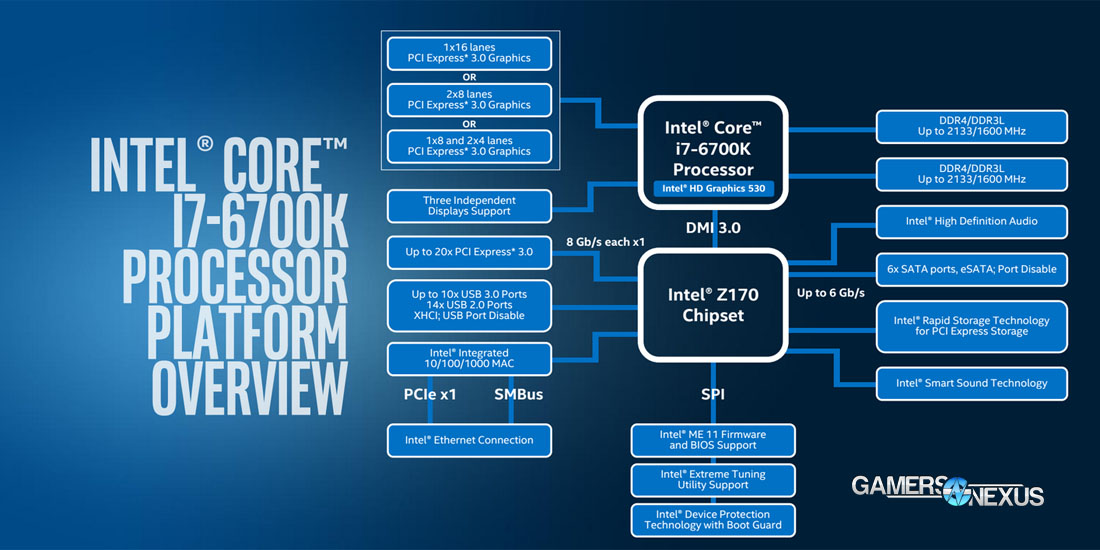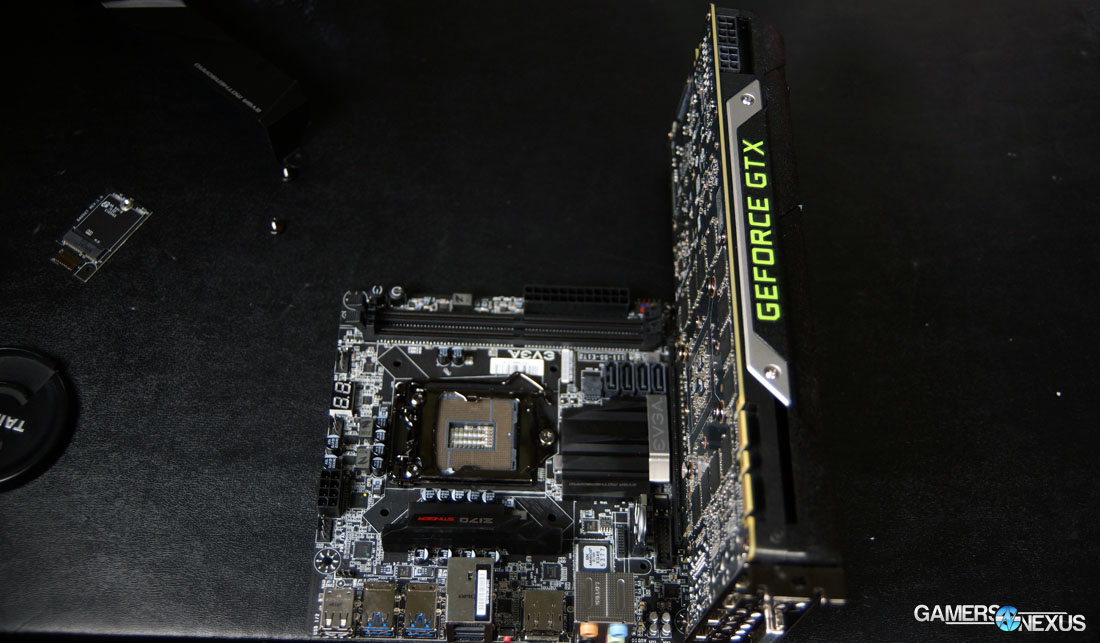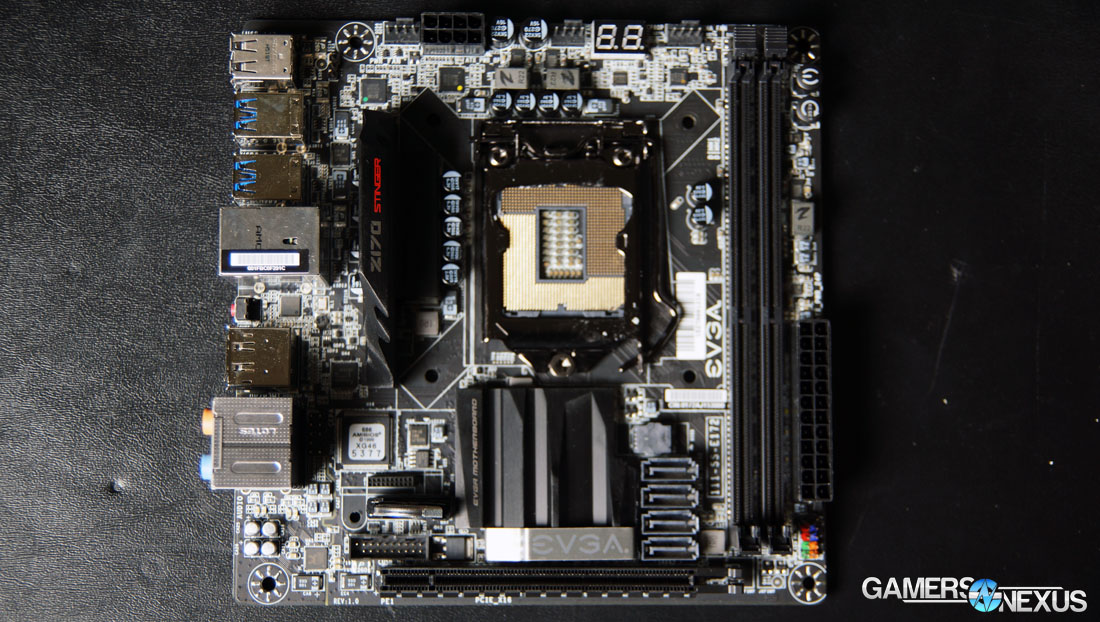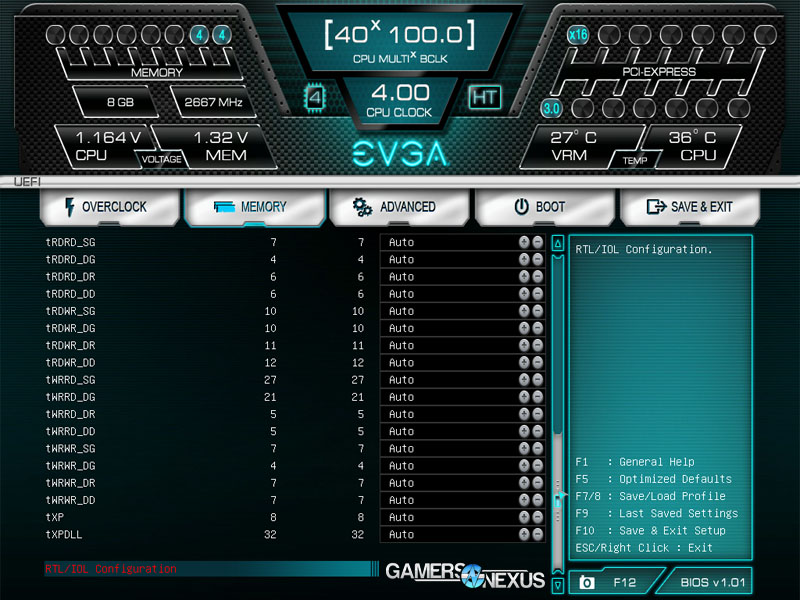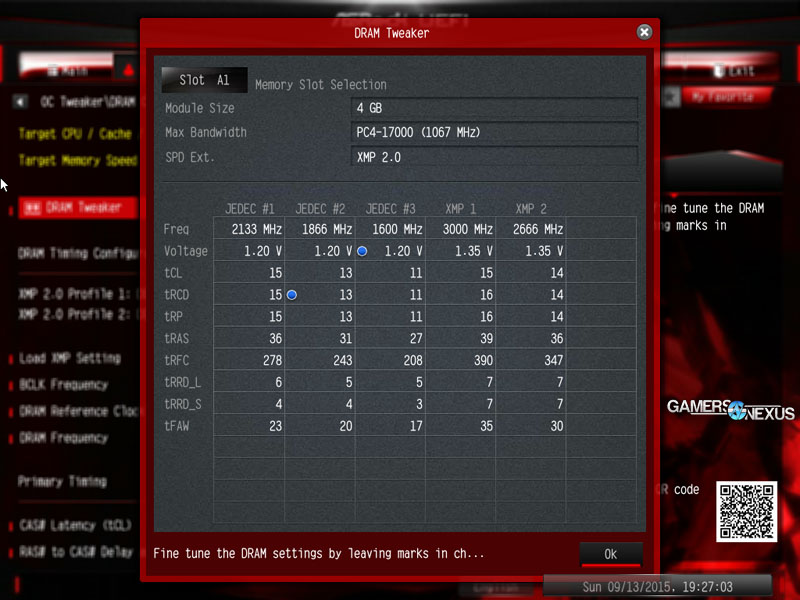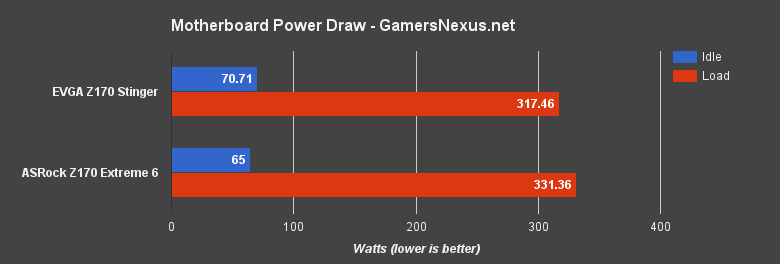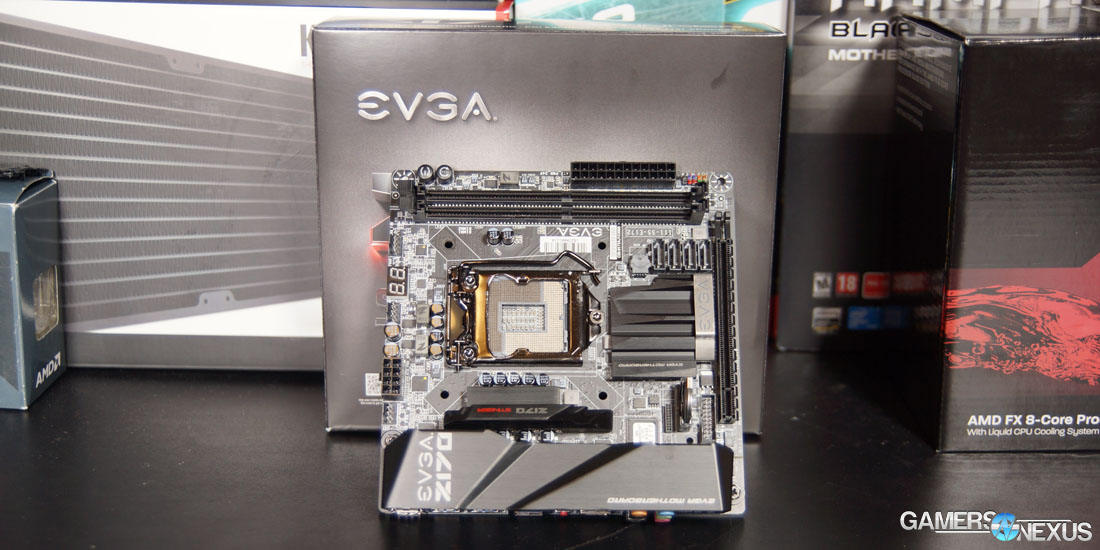EVGA Z170 Stinger Mini-ITX Motherboard Review & Overclocking
Posted on September 14, 2015
EVGA's Z170 Stinger ($200) motherboard, something we reported on months ago, markets itself on enthusiast-level features in a mini-ITX form factor. The motherboard hosts Intel's newest “Performance” Z170 chipset, meaning it supports the latest i7-6700K, i5-6600K, and all the other forthcoming Skylake CPUs.
The Z170 Stinger is inherently restricted by opting for a mini-ITX form factor, but attempts to make the best of the space available with careful selection of supported I/O through the chipset. The unit hosts a single PCI-e slot and two memory slots – standard for mITX – along with a set of four SATA ports. This is reserved compared to larger motherboards, but allows a 6.7” x 6.7” size for use in SFF or gaming HTPC system builds.
Our review of the EVGA Z170 Stinger gaming motherboard will run through the specs, cooler clearances, BIOS, and relevant tests. Aesthetics aren't really something we like to discuss – the photos do that – but we'll talk through a few key points on that front, too.
EVGA Z170 Stinger Motherboard Specs
- Chipset – Intel Z170
- SLI – N/A
- SATA – 4 SATA 6G
- RAID 0, 1, 5, 10, JBOD
- USB – 6 USB 3.0 / 2 USB 2.0
- Memory Support – 2 DIMM Dual-Channel DDR4 3200MHz+ (up to 32GB)
- Capacitors – POSCAP/Solid State
- Ethernet – 1x Intel® Gigabit NIC
- Audio – 8 Channel High Definition Audio
- DisplayPort – 1x DP 1.2, 1x HDMI 1.4
- Fan Headers – 3 (1 PWM, 2 DC)
- PCB – 10 Layers
- PCI-E Slot Arrangement – 1x16
- NVMe Support – Yes (PCI-E)
- mITX Form Factor
- Length: 6.7in - 170.18mm
- Width: 6.7in - 170.18mm
- USB 3.0 Support
- SATA 6G Support
- 8 Channel High Definition Audio
- 100% Solid State Capacitors
- EVGA Vdroop Control
- EVGA E-LEET Tuning Support
- Onboard Clear CMOS, Power and Reset Buttons
- Onboard CPU Temperature Monitor
- PCI Express 3.0 Support
- 150% Increased Socket Gold Content
- Supports Intel Core i3, i5, and i7 Socket 1151 Processors
- 2 DIMM Dual-Channel DDR4 3200MHz+ (up to 32GB)
The Z170 chipset is the Stinger's brainstem. Intel's Z170 chipset makes a few key changes over Z97 (which we've written about), primary of which is is the allowance for board manufacturers to better differentiate their offerings.
Board partners can determine where Z170's PCI-e lanes are going – direct to PCI-e slots, to M.2 / storage slots, or to more USB3.x ports. The 20 PCI-e lanes are in clusters of four, making five sets of four lanes for PCI-e device mapping. Some of these lanes are pre-allocated to technologies Intel has deemed critical or non-negotiable, like RST (Rapid Storage Technology) for RAID configurations. The division of lanes means that expansion cards can be maximally powered with an x4 assignment, so multi-GPU builds will pull from the CPU's lane allotment or rely on PEX chips for multiplexing.
These 20 PCI-e lanes are part of Z170's 26 HSIO (high-speed IO) lanes, which the manufacturer has relative freedom to customize. SATA, M.2, USB, Gigabit Ethernet, multi-Ethernet, and other IO options are on the table for inclusion. Z170 also introduced support for digital microphone direct attach, eliminating the requirement of a separate audio codec on the board. EVGA is doing their own audio processing through a Realtek chip, but cheaper boards can now get away with even more limited components than before.
FIVR, Haswell's on-chip VRM, has been axed in Skylake and VRM control is again in the hands of the motherboard. This reduces thermal hotspots on the die and returns some of the differentiating factor to motherboards, which have slowly grown more similar over the many generations (memory controllers used to be hosted on-board, not on-chip, for instance).
EVGA's Z170 Stinger hosts a fairly simple 4-phase power design voltage regulator module. This could sound small in the shadow of Gigabyte's 22-phase Gaming G1 motherboard, but quality of phase design and CPU efficiency reign king. Skylake is known to be supremely power-efficient and will survive happily on a 4-phase VRM unless engaging in more extensive overclocking. This is something we will explore more in a future article, as we've currently only got the Stinger Z170 board and a pre-production ASRock K6, with 12 phases. The pre-production K6 is not stable enough for a head-to-head OC comparison.
(Above: A Titan X provides perspective)
EVGA allocates its HSIO to 4x SATA III slots (DEVSLP enabled), 6x USB3.0 & 2x USB2.0 ports, 1x gigabit Ethernet, 1x PCI-e 3.0 x16, and 1x M.2 Key E (for wireless or BT adapters).
Somewhat brilliantly, EVGA uses a raised M.2 adapter card protruding vertically from the motherboard to save space. Without this solution, it would be impossible to fit the M.2 slot on the board. The riser card is optional (shown in some of our photos, absent in others) and is not pre-installed. Another optional, included item is the I/O cover, purely an aesthetic add. We don't use these in our builds, but users more interested in aesthetics would welcome the brushed covering.
Other major points include usage of a Realtek 8-channel audio controller, support for 3200MHz DDR4, and a 10-layer PCB for more ESD protection and stability with high voltages.
Socket Clearance from DIMM & PCI-e Slots
All the components are going to get pretty “friendly” in a mini-ITX form factor motherboard. The proximity of the PCI-e slot to the CPU socket is tight, measured (by us) at 50mm from the bottom-left CPU bolt to the VGA. The clearance is only as large as it is because the chipset buffers the space in between. We had about 2mm of clearance between our memory heatsink and the outer edge of the bottom-right/top-right CPU bolts.
There is effectively zero space between the CPU socket mounting points and the left VRM heatsink, but EVGA has (thankfully) made the heatsink small enough that the CPU bolts are easily accessed. This is a problem we've had with a number of motherboards. Because the VRM heatsink is shorter in length, the CPU heatsink mounting bolts are openly exposed and easy to access.
The left-side VRM heatsink measures about 31-32mm tall, making it short enough that most CPU coolers will clear the VRM sink. Check your bottom-out point to be sure.
Users would have issues mounting some larger CPU air coolers without careful selection. Memory clearance is necessary, as almost any air cooler will bleed over the DIMM slots. We had no issues whatsoever installing our generic Asetek 550LC liquid cooler. Smaller profile air coolers will still work. It is advisable to avoid purchasing a multi-fan air cooler with a large aluminum heatsink.
EVGA Z170 Stinger BIOS & UEFI
The Stinger uses a UEFI resolution of just 1024x768, something we've seen surpassed by new, HD UEFI menus on some boards. Then again, most of us at GN grew up on blue-and-white BIOS screens, so it does feel hard to complain about a 1024x768 GUI.
UEFI layout for the Stinger is fairly straight-forward. For a $200 board, the BIOS doesn't bear the resemblance of some other high-end boards on the market. In a sense, this is OK – it's easier to understand the options for less serious overclockers. Digging into some of the OC settings reveals that BIOS, despite its graphical simplicity, is fairly feature-complete. Memory timings are a testament to this, allowing deep-dives into tertiary and RTL/IOL configuration. Some CPU tweaking is absent, like finer control over the cache clock, but anyone seeking such access would do better to purchase a larger, more outfitted motherboard.
Item descriptions provide some basic insight as to what each option actually does – a good thing for usability – though we think the CPU base clock (BCLK) probably deserves a bit more 'help' text; BCLK overclocking has become relevant again in Skylake and will be a point of focus for overclockers. The EVGA Z170 Stinger's BIOS should be easy for new users to navigate and tune.
Unlike some BIOS menus, there isn't really an “easy mode” and “advanced mode” for the Z170 Stinger – it's all just there, which is fine for most people. Preferable, even. That stated, the Stinger's UEFI BIOS does lack a few options we've grown to like in other motherboards. A pop-up detailing all the XMP and JEDEC options, for instance, would be warmly welcomed (pictured above). ASRock's provided such tuning options in motherboards, even adding the ability to 'flag' timings as a note-to-self of successful endeavors. Note taking within BIOS is, in the nerdiest of senses, very cool. We'd like to see that here. Gotta save something for the high-end, I suppose.
(Above: ASRock's memory notation utility)
The HW Monitor includes the usual cooling and “smart” cooling options, complete with preconfigured fan curves. Three 4-pin fan headers are available on the board, including CPU_FAN.
Constructively, based on something we've observed recently in other boards, it'd be welcomed to see a “spin-up / spin-down” timer on the fan RPMs. This forces the motherboard to wait a user-defined period of time prior to altering fan RPM, ensuring that the RPM increment is actually necessary. Such an implementation would restrict the possibility of the wobbly, awkward RPM swapping as thermals find their resting place. Normally, I really wouldn't care about this – but we're looking at a mini-ITX motherboard. These types of boards end up in HTPCs that sit next to TVs, which demand absolute silence for the best home theater experience. Smoothing out the fan RPMs assists in this.
Continue to page 2 for the tests and conclusion.
Test Methodology
We're still developing Z170 / Skylake test methodology and, until we've received production-level boards and chips, we can't do a lot of direct comparisons. As it stands now, our Core i7-6700K is an engineering sample and our ASRock Extreme K6 motherboard is a pre-production sample; neither is safely assumed purely representative of the user experience.
For now, we've only done power draw and boot time comparisons, with OC testing being relegated to just the Z170 Stinger.
Power draw was tested with BIOS settings configured to default, sans memory (2667MHz). Intel's power saving options were enabled as recommended for this test. Idle and load were both measured with a wall-to-plug Kill-A-Watt meter. Load was tested by running 3DMark Firestrike Extreme (combined test) on loop for ten minutes, at which point the total system power draw was plotted.
Boot times were stop-watch timed. Fast boot was disabled. No OC was applied. Memory was at 2667MHz. Tests were repeated for parity a minimum of 5 times.
Overclocking didn't work on our pre-production Extreme K6, so it was eliminated from the test. We tuned vCore and the CPU multiplier incrementally, ran a Prime95 LFFT burn-in, and modified settings depending on pass/fail of that test.
Bench is below.
| GN Test Bench 2015 | Name | Courtesy Of | Cost |
| Video Card | NVIDIA | $650 | |
| CPU | Intel i7-6700K CPU | iBUYPOWER | $340 |
| Memory | 16GB HyperX Predator DDR4-3000 | Kingston Tech. | - |
| Motherboard | This is what we're testing! | - | - |
| Power Supply | NZXT 1200W HALE90 V2 | NZXT | $300 |
| SSD | Kingston V300 SSD | iBUYPOWER | - |
| Case | Top Deck Tech Station | GamersNexus | $250 |
| CPU Cooler | Asetek 550LC | Asetek | - |
EVGA Z170 Motherboard OC vs. ASRock Extreme 6
So, first off, this isn't really what you'd call a “linear comparison.” Both motherboards are good, both are Z170 – but one is a full ATX board (the Extreme 6) and one is for mini-ITX builds. Realistically, no user who is considering the mini-ITX Stinger is simultaneously considering the Extreme 6 for the same build. Our ASRock board is, as noted above, a pre-production model, so we also can't do stable overclocking tests on the unit. These test holes stated plainly, they're the only two Z170 boards we've got right now, and they'll still provide a baseline going forward. Z170 is still new and we're still getting board review samples in.
We only ran a few tests here, starting with system power draw, then boot times, then finishing with overclocking potential.
EVGA Z170 Stinger Motherboard Power Draw
The Stinger draws ~14W less than the larger, more-equipped Extreme 6, sitting at 317.46W total system power draw (load). The board consistently drew about 5W more than the Extreme 6 when idle.
EVGA Z170 Stinger Motherboard Boot Times
Boot times favored the K6 at 18.2s to load Windows 8.1 (via SSD). The Stinger required an average of 23 seconds to boot to desktop.
Conclusion & Overclocking
EVGA's Stinger motherboard is somewhat isolated in its form factor and price point. There aren't many Z170 mini-ITX boards yet, and the ones that exist aren't generally targeting the same audience. Gigabyte's GA-Z170N Gaming 5 includes wireless functionality (natively lacking in the Stinger), but has a weaker VRM and just two SATA ports. ASRock's price-adjacent mini-ITX competitor crams a whole lot of stuff on the board, including two more SATA ports, a wireless adapter, and a USB2 header (lacking on the Stinger, which is problematic for Kraken X-series users). We haven't yet tested or seen the ASRock Gaming-ITX board and can't comment on its build quality as of yet.
As for the Stinger, it's a powerful, space-efficient little motherboard. The board held a 46x / 1.380v overclock (4.6GHz) and 3000MHz RAM with stability. We were unable to push beyond this point, but will attempt to do so again once more boards are in-hand. You won't be doing extreme OCs on a 4-phase board, but for the majority of users, the Stinger will get by just fine with a moderate ~15-20% OC.
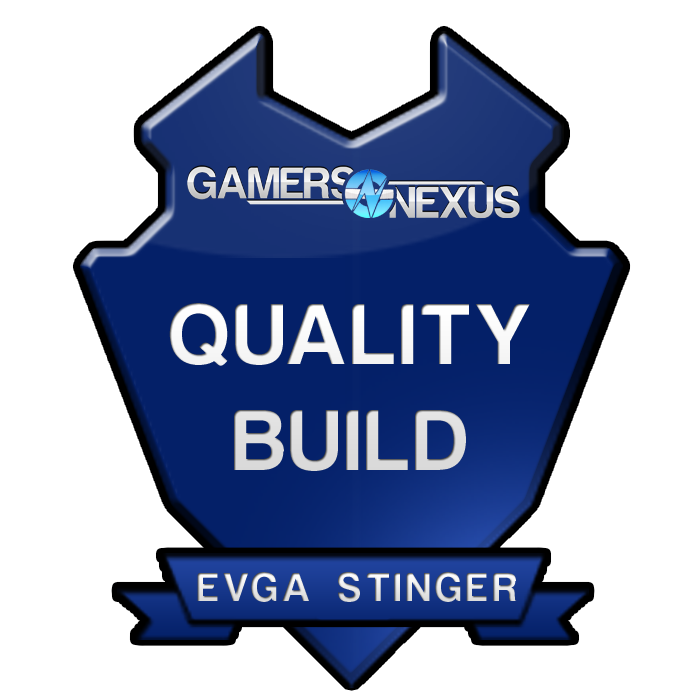 EVGA's UEFI BIOS is navigable and offers basic usability notation for users who might require some guidance. That said, we still think it could be improved in a few ways. There are a few tweaking options (detailed above) that we'd like to see added.
EVGA's UEFI BIOS is navigable and offers basic usability notation for users who might require some guidance. That said, we still think it could be improved in a few ways. There are a few tweaking options (detailed above) that we'd like to see added.
At $200, the Z170 Stinger is steeply-priced and fits a niche market: HTPC builders who require some enthusiast-grade OC support on a limited-phase board. It isn't for everyone. Budget users in the HTPC market must look elsewhere, and anyone requiring more options should be building using a larger form factor. For the market fitting of such a board, the Z170 Stinger is built to high-quality standards and has sharp aesthetics (with a well-executed, matte black PCB). The capacitors, chokes, and limited cooling are all of high build quality, with a well-engineered VRM design on-board.
Learn more here: https://www.evga.com/Products/Product.aspx?pn=111-SS-E172-KR
- Steve "Lelldorianx" Burke.
